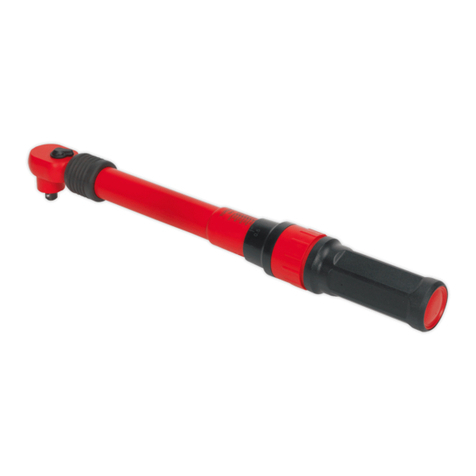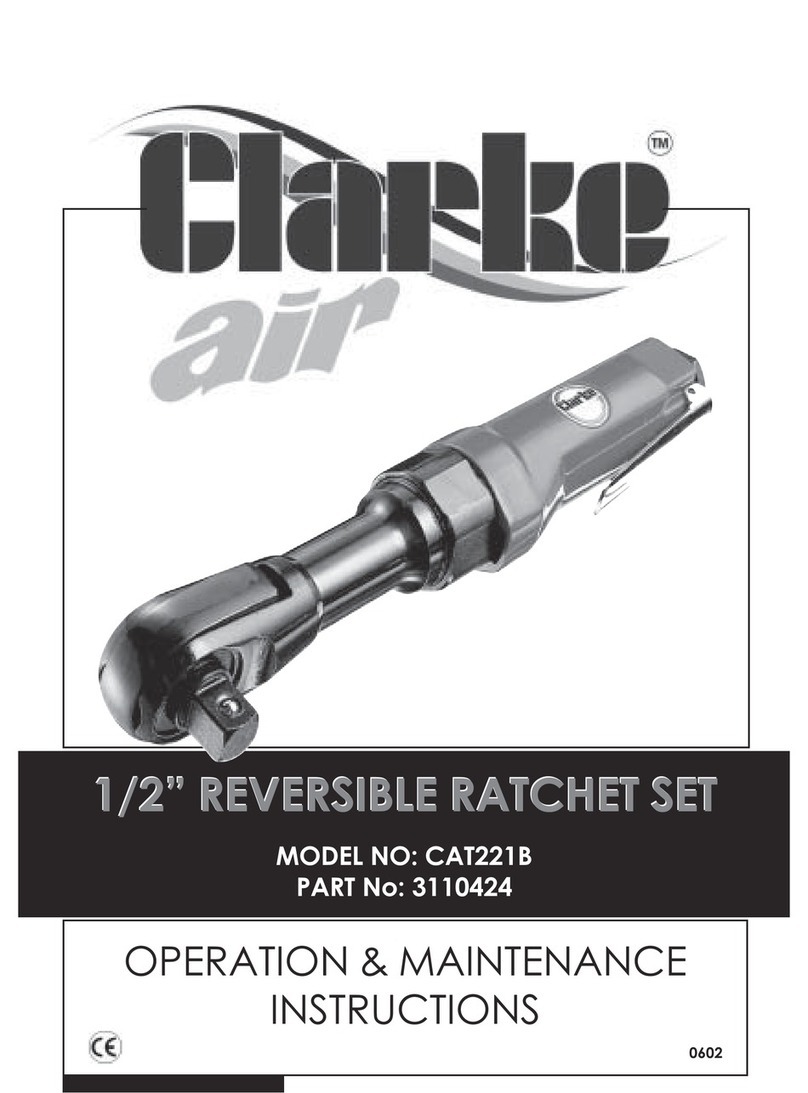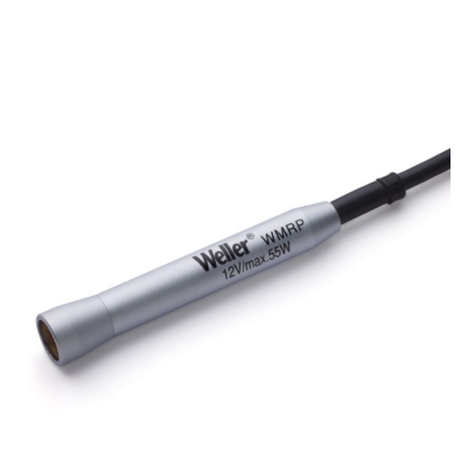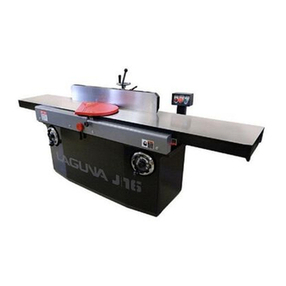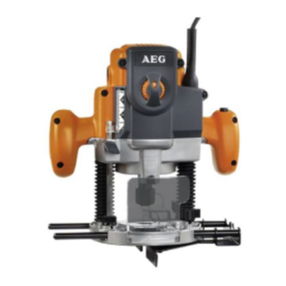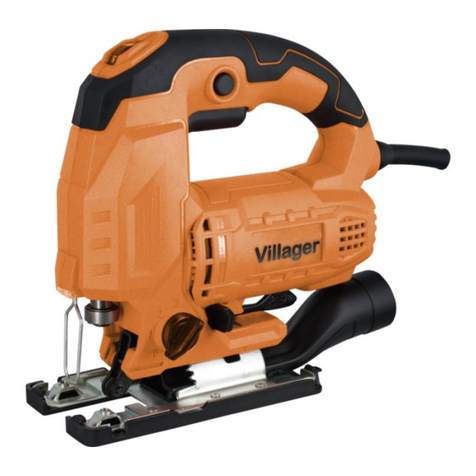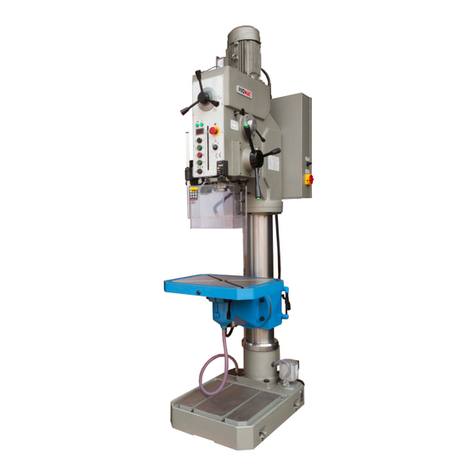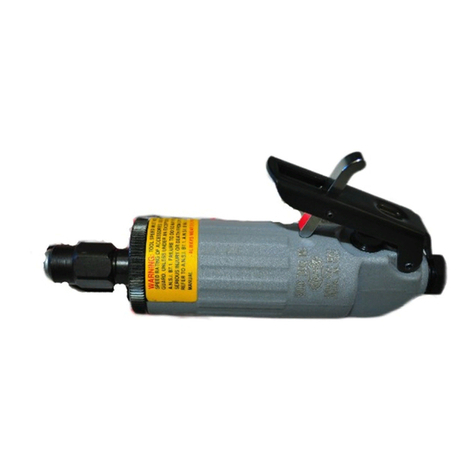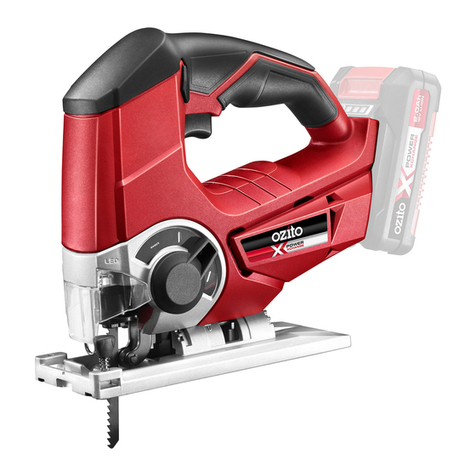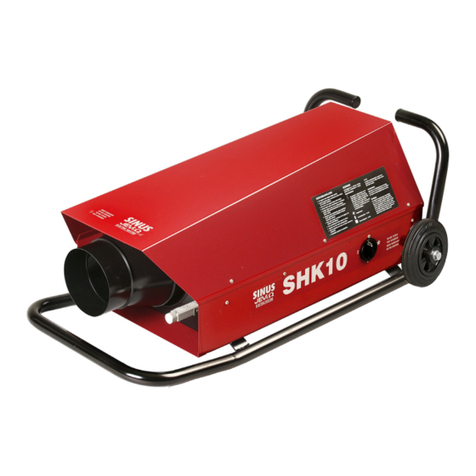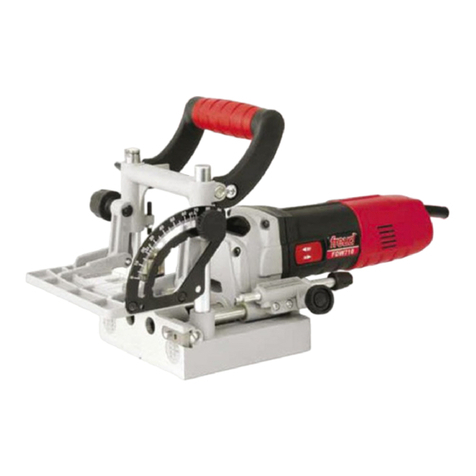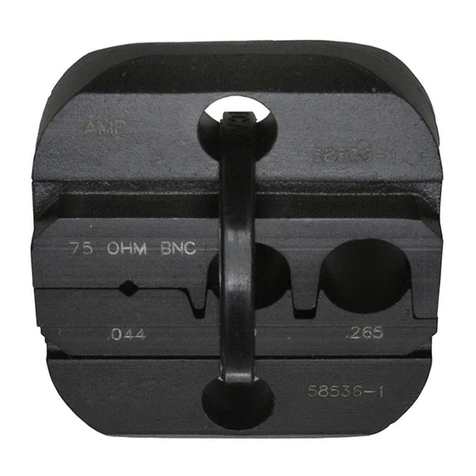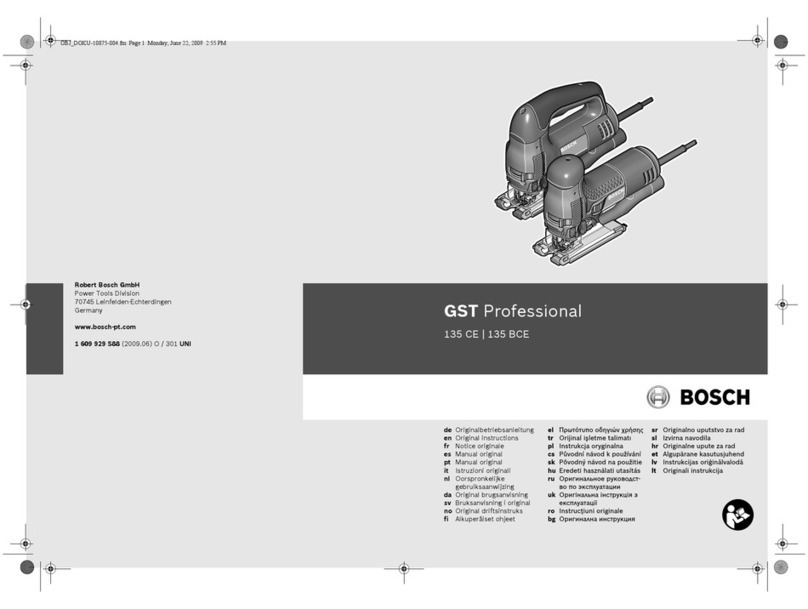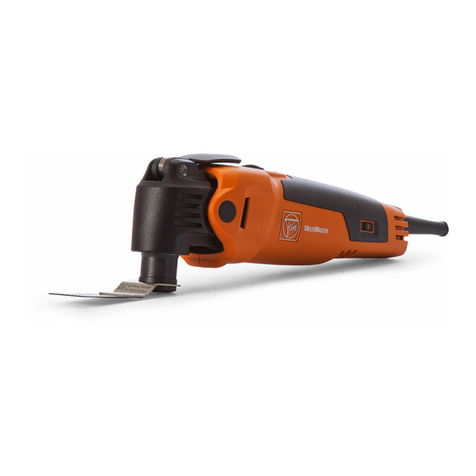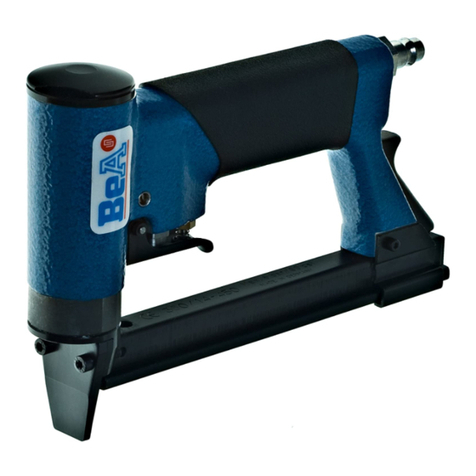Specac Atlas 15T User manual

Atlas™ Manual 15Ton (15T) and 25Ton
(25T) Hydraulic Press
User Manual
2I-15011 Issue 13


Atlas™ Manual 15T and 25T Hydraulic Press
3
Atlas™ Manual 15Ton (15T) and
25Ton (25T) Hydraulic Press
User Manual
2I-15011 Issue 13

User Manual
4
Atlas™ Manual 15T and 25T Hydraulic Press
MANUALLY OPERATED HYDRAULI PRESS, (15 AND 25 TON)
CONTENTS - USER MANUAL
1.
I
NTRODUCTION
................................................................................. 5
2.
S
PECIFICATIONS OF THE
A
TLAS
™
M
ANUAL
H
YDRAULIC
P
RESS
. .......... 6
3.
U
NPAC ING AND
I
NSTALLATION
......................................................... 7
4.
S
AFETY
C
ONSIDERATIONS WHEN
O
PERATING THE
P
RESS
................. 11
5.
O
PERATION OF THE
P
RESS
............................................................. 12
C
ONTROL OF A
M
AXIMUM APPLIED
L
OAD
.......................................... 15
L
EADSCREW
A
SSEMBLY
.................................................................. 17
6.
F
AULT
F
INDING
,
C
AUSES AND
R
EMEDY
............................................ 18
L
OSS OF
P
RESSURE IN THE
P
UMPING
S
YSTEM
................................. 18
B
LEEDING
A
IR FROM THE
P
UMP BLOC
A
SSEMBLY
........................... 20
B
LEEDING
A
IR FROM THE
P
ISTON
A
SSEMBLY
................................... 22
P
ISTON
D
OES
N
OT
R
ETURN
W
HEN
P
RESSURE IS
R
ELEASED
............ 23
7.
L
EGEND
......................................................................................... 24
S
PARE
P
ARTS
................................................................................. 25
© April 2014 Specac Ltd. All rights reserved.
Brilliant Spectroscopy is a trademark of Specac Ltd.
Other product names mentioned herein may be trademarks
of their respective owners.

Atlas™ Manual 15T and 25T Hydraulic Press
5
1. Introduction
Thank you for purchasing a Specac product.
The Specac Atlas™ Manual 15T and 25T Hydraulic Presses have
been designed for a wide variety of pressing applications, but they are
specifically suited to the preparation of Br discs using Specac
evacuable pellet die assemblies.
The presses can be adapted to provide heated pressing surfaces with
Specac Heated Platens and a Temperature Controller (P/N GS15515).
These heated pressing surfaces can be used for the preparation of thin
films in conjunction with use of the Constant Thickness Film Maker
Accessory (P/N GS15640). The High Temperature Film Maker
Accessory (P/N GS15800) can also be used with the Specac presses.
(The Heated Platens P/N GS15515 are not required for use with the
High Temperature Film Maker Accessory P/N GS15800 as this
accessory has its own heated pressing surfaces).
The Atlas™ 15T and 25T manual presses work by hand pumping a
hydraulic fluid (oil) to raise a piston and compress a sample held in the
pressing area. The press consists of a pump block assembly, where
the oil is pressurized by the simple pumping action from a handle, and
the sample pressing side, where the pressurized oil is forced under the
piston assembly. When resistance is offered by a sample, the pressure
build up in the system is shown on the 15 or 25 Ton load gauge,
located on the pump block assembly.
In addition to the standard versions of the press providing maximum
tonnage loads of 15 and 25 tons, there are low tonnage gauge
conversion kits available for allowing finer load readings over smaller
ranges. These ranges are from 0-1 tons, 0-2 tons and 0-5 tons. The
lower tonnage gauges are connected additionally in line with either the
standard 15 or 25 ton gauge. With these lower tonnage gauges
switched on, the press can only be used up to the maximum tonnage
load limit of the lower gauge that has been fitted.

User Manual
6
2. Specifications of the Atlas™ Manual
Hydraulic Press
E Marking ompliance
The Atlas™ Manual Hydraulic 15T and 25T Presses do not require and
indeed must not be CE Marked. Under the Pressure Directive
97/23/EC regulations, because these presses fall below the stated
pressure and volume limits, Specac adopts SEP (Standard
Engineering Practice) to ensure the safety in use of these products.
Maximum Height (at pump handle) 610 mm
Maximum Width 310 mm
Maximum Depth 190 mm
Weight 50 g
Lower Piston Stroke 25.4 mm
Upper Lead Screw Travel 89 mm
Minimum Daylight (Distance Between Pressing Faces) 38 mm
Maximum Daylight (Distance Between Pressing
Faces)
152 mm
Lower Pressing Face Diameter 86 mm
Upper Pressing Face Diameter 32 mm
Maximum Width Of Sampling Area (side to side) 134 mm
Maximum Depth Of Sampling Area (back to front) 141 mm
Oil Capacity 0.284 Liters
(0.5 Pint)
Oil Type CL 37

Atlas™ Manual 15T and 25T Hydraulic Press
7
3. Unpac ing and Installation
Beware! This press is very heavy and care must be taken
to transport it properly. This will protect you and the press
from accidental damage or injury.
The press leaves the factory in specially designed packaging. It sits on
a wooden pallet and has a thick outer cardboard casing held to the
pallet by three tie straps. There are direction arrows on the casing
indicating which way up the press is to be handled.
To unpack the press first cut the three straps with a sharp knife and lift
up the outer cardboard casing from the pallet.
Fig 1. Atlas™ Manual Hydraulic Press Provided as Packaged
The press has internal transport packing around the top, by the lead
screw handle. (See Fig 1.) This packing is four pieces of cardboard
stacked on top of each other, held tight by the lead screw handle and
Leadscrew
Handle
Four Packing
Pieces to Remove
Wooden
Pallet
Pump
Handle
Pressure/Load
Gauge

User Manual
8
supporting the pump handle in an upright position. To remove these
four pieces loosen the lead screw handle (turn anticlockwise) and then
carefully lift them up and over the lead screw handle.
The press is now ready to be lifted off of the wooden pallet. There are
two holes in the upright frame supports on the sample pressing side of
the press (used for vacuum tubing when an evacuable pellet die is in
the press – see Fig 2.). These two holes can be used to lift up and
position the press by passing strong nylon rope through them to
provide a sling. If available, a hoist can be used to lift the press via this
sling. If a hoist is not available, then a minimum of two people will be
required to lift the press. Use heavy-duty gloves and lift the press from
underneath by the base casting. DO NOT ATTEMPT TO LIFT THE
PRESS BY THE LEAD S REW HANDLE OR PUMP HANDLE.
Fig 2. Lifting Holes and Base asting Fixing Holes
Place the press in its working position. In certain circumstances, it may
be necessary to attach the press permanently to a laboratory bench.
Two 10 mm diameter holes are provided in the base casting for this
Holes i
n Frame
Supports that
can be used for
Lifting
Base asting
Fixing Holes
(Other in
Opposite orner)

Atlas™ Manual 15T and 25T Hydraulic Press
9
purpose. (See Fig 2.) It is recommended that M8 diameter bolts are
used to secure the press and that the bench top is at least 25 mm thick
to take the weight of the press.
The press is supplied filled with hydraulic oil and is ready to use. The
only preparation required before operation is to remove the nylon vent
screw (37) from the pump plate (36) of the pump block assembly.
Fig 3. Nylon Vent Screw (Transportation Screw) to Remove
Note: A light smearing of oil is applied around the main pressing piston
area (4 and 5) when the press is supplied as new. It is perfectly
normal and not a sign that oil is leaking.
Please keep the press packing materials for future transportation.
Replacing a press in its packaging is the reverse of the procedure
described previously.
For any inquiries to Specac regarding the press the serial number
must be quoted. The serial number is a five digit number preceded by
a letter of the alphabet e.g. H, and is found engraved on the press at
the rear of the pump block assembly. The serial number is also on the
Test Certificate found at the rear of this manual.
36
37

User Manual
10
If you need to contact Specac regarding a service or repair issue
relating to an Atlas™ Manual Hydraulic Press, please be as specific as
possible regarding the nature of the enquiry. Please quote the serial
number for the press, identify how the press is being used and provide
as much information as you can.
Where possible, if contacting by email, please provide photographs too
as these can help greatly to understand the nature of the enquiry.
Fig 4. Rear View of 15/25 Ton Atlas™ Manual Hydraulic Press
Serial Number
Location

Atlas™ Manual 15T and 25T Hydraulic Press
11
4. Safety Considerations When Operating the
Atlas™ Manual Hydraulic Press
Under the Pressure Directive 97/23/EC, because these presses fall
below the stated pressure and volume limits, EC Marking compliance
is exempt. Therefore Specac adopts SEP (Standard Engineering
Practice) to ensure safety in use of these products.
The Atlas™ Manual Hydraulic Press is provided with front and rear
safety guards (65). These must be kept closed (lowered) at all times
when a sample is being pressed. The guards will fall to the lowered,
safe position if not purposefully raised or kept open by other means.
Note: The use of press guards is a
requirement for any high tonnage load
applications. hen using the Specac Film
Making Accessories P/N's GS15640 and
GS15800, although the tonnage loads to
apply are typically 1 to 2 tons, Specac
advise that the safety guards are used
wherever possible.
hen using a Film Making Accessory it is
a requirement that the pressure relief
valve assembly (66 to 72) on the Atlas™
Manual Hydraulic Press is adjusted to
read a 2 tons maximum load at the load
gauge (31) for safety and prevention
of tonnage overloading to the Film Making
Accessory itself.
If you ever need to move or reposition the press, always lift it from
underneath the base casting (1). Do not move it by pulling or lifting the
pump handle (32), load gauge (31), or lead screw handle (20). It is
recommended that a minimum of two people are used to lift or move
the press.
65 1

User Manual
12
5. Operation of the Press
(The text for “bubble part” number identification also refers to the 2D
Diagrams Figs 13. to 18.found at the back of this manual).
The press is supplied filled with hydraulic oil and is ready to use. The
only preparation required before operation is to remove the nylon vent
screw (37) from the pump plate (36) of the pump block assembly.
(Please refer to Fig 3. on page 9.)
Fig 5. Front View of 15/25 Ton Atlas™ Manual Hydraulic Press
21
65
23
5
20
30
33
31
32
4

Atlas™ Manual 15T and 25T Hydraulic Press
13
Raise the front safety guard (65) and place the work to be pressed on
the lower bolster pressing face (5) covering the piston (4). Ensure that
the work is positioned centrally and lower the safety guard. Screw
down the top bolster pressing face (23) attached to the lead screw
(21), by turning the lead screw handle (20) clockwise.
Important: Ensure that all the components of the work to be pressed
(usually a die set) have been squeezed tightly together
before starting to pump a pressure. However, leave a 1mm
gap between the top of the die set and the top bolster (23)
pressing surface to allow for some initial travel of the
pressing piston (4) on the press.
Rotate the pressure release handle (30) clockwise until it has tightened
firmly. This closes the pumping system so that it is ready for you to
build up the pressure with the pump handle grip (33).
Warning: Ensure that the safety guard is lowered before pumping.
Now start to pump the press by pulling and pushing gently, but
smoothly, on the pump handle grip (33). (The correct leverage and
force is applied by holding at the rubber handle.) It will take a few
strokes to build up pressure in the oil, but once resistance is offered by
the work to the raising of the piston, the load will be indicated on the
load gauge (31). eep on pumping until the required load is achieved.
There is a maximum piston (4) travel of 25 mm. There is a red ring
around the piston (4) showing when the limit is reached (See Fig 6.)
DO NOT ONTINUE PUMPING WHEN THIS RED RING SHOWS.
If you do not stop pumping, you will cause damage to the press
mechanism.
There is an internal spring stud (16) within the piston (4) assembly that
is designed to break, protecting the press if the allowed piston travel is
exceeded. This spring stud (16) allows the action of the piston spring
(19) to pull the piston (4) back down when the oil pressure in the
system is released. If the stud (16) breaks, the spring (19) is not
compressed when the piston (4) is pumped, consequently the piston
will not return easily to the start position once the pressure is released.

User Manual
14
Fig 6. Maximum Limit of Piston (4) Travel (Red Ring Showing)
If the work (e.g. a sample in a die set) is compressing to the extent that
the piston (4) has travelled to show the red line but the compression
load has not been reached, release the pressure by turning the
pressure release handle (30) anticlockwise (slowly) by about one
complete rotation. This will allow the piston (4) to return to rest. The
work will sink down with retraction of the piston (4) and a gap will be
created between the work and the top bolster pressing face (23). Turn
the lead screw handle (20) clockwise to bring the top bolster pressing
face onto the work again, and reapply the load from the piston (4) -
retighten the release handle (30) and pump via pump handle (33).
Note: This procedure should be followed with samples that are highly
compacted when compressed within an evacuable pellet die.
When the required load is indicated on the load gauge (31), stop
pumping. The pressure and applied tonnage load against the work will
be held for as long as required. You may observe a slight decrease in
the pressure applied, indicated at the load gauge (31), as the work
(sample) being pressed may relax over time. You can bring the
pressure back up to the required load if desired by pulling gently on the
pump handle grip (33) again.
31
23
5
4
Red
Ring

Atlas™ Manual 15T and 25T Hydraulic Press
15
Note: If the applied tonnage load set at the load gauge (31) drops by
more than one ton over a 15 minute period, this may indicate
that there is a fault in the system for holding the applied
pressure, rather than from any relaxation in the work being
pressed. The press system may require bleeding of any trapped
air in the oil to function correctly. (See Fault Finding, Causes and
Remedy, Section 6, page 20.)
To release the load on the work turn the pressure release handle (30)
anticlockwise, slowly, by about one complete rotation. (There is no
need to turn this handle completely open.) Slow rotation of the release
handle (30) allows for a gradual and controllable release of the
pressurised oil within the system (indicated by a gradual drop of the
applied tonnage load at the load gauge (31)), to drain back into the oil
reservoir and helps to reduce the possibility of any bubbles that might
form in the oil from a rapid release of pressure.
ontrol of a Maximum Applied Load
Beneath the pressure gauge (31) there is a pressure relief valve
assembly (66 to 72) which may be set so that any load between 0-15
tons or 0-25 tons is the maximum load that can be obtained.
(See Fig 7.) The relief valve set knob (69) can be rotated clockwise to
increase the maximum pressure in the system, and hence the applied
load, or rotated anticlockwise to decrease the pressure in the system.
Note: hen supplied the pressure relief valve will be set for a 10 ton
load on the 15 ton press and a 15 ton load on the 25 ton press.
To set a specific maximum load, first rotate the relief valve set knob
(69) anticlockwise until it is held loosely by a couple of screw threads.
(Be careful, as if you unscrew the knob completely the relief valve ball
bearing (70) held behind the knob (69) could fall out of position and be
lost. (If the ball bearing (70) does fall out just simply place it into the
knob (69) head recess and screw back into position.)
Place a piece of work to be pressed in the usual way, close the
pressure release handle (30) and start to pump. If the pressure relief

User Manual
16
Fig 7. Pressure Relief Valve for Setting a Maximum Load
valve is fully open, there will be no pressure build up in the system (the
pressure/load gauge (31) indicator will not rise and show a load) and
excess pressure being pumped will vent off at the relief valve. Now,
start to turn the relief valve set knob (69) clockwise, (one complete
rotation at a time) and continue pumping. Eventually, pressure will
begin to build up in the system and the gauge (31) indicator will rise to
show a tonnage load. Once the load limit for the setting of the pressure
relief valve knob (69) has been reached, excess pressure will once
again vent off at the relief valve. Continue to turn the relief valve set
knob (69) clockwise until the required pressure/load is reached.
If you overshoot the pressure and hence load limit you require from
over-adjustment clockwise of the knob (69) and continuous pumping of
the handle (32), simply release the pressure from the system by
opening the pressure release handle (30) and then closing the release
handle again. Turn the pressure relief valve knob (69) anticlockwise to
reduce the load limit and re-pump the press via the handle (32).
Repeat the process as necessary to achieve the maximum applied
load setting required.
31
30
66-72
32
69

Atlas™ Manual 15T and 25T Hydraulic Press
17
Tip: This is a useful feature for pressing applications where a
maximum load limit is required. For example, 10 Tons maximum
for 13 mm evacuable pellet dies P/N GS03000.
Beware! ith the pressure relief valve set knob (69) turned fully
clockwise it is possible that the press will reach and go
beyond the maximum load rating for the press; that is beyond
the 15 and 25 ton gauge divisions. Therefore, the pressure
relief valve knob (69) m st only be turned clockwise as far as
to obtain the 15 ton or 25 ton gauge division indication when
a maximum load is being applied.
Over press rization of the press re ga ges will ca se
damage to the ga ge mechanism res lting in the need for
replacement.
Lead Screw Assembly
In operation the leadscrew assembly (handle (20) and leadscrew (21))
is used to adjust for the height of the work to be pressed. Rotating the
leadscrew clockwise lowers the leadscrew bolster (23) pressing face
towards the work and turning the leadscrew anticlockwise raises the
bolster (23) away from the work.
Fig 8. Leadscrew Assembly and Top Bolster Parts of the Press
The bolster (23) push fits into the hollow of the leadscrew (21) and is
retained by an O-ring (22). Any pressing of work must always be
carried out using the bolster (23) pressing face suitably attached
into the leadscrew (21) assembly via the O-ring (22) fixing.
23
22 20
21

User Manual
18
6. Fault Finding, Causes and Remedy
The Atlas™ Manual 15T and 25T Hydraulic Presses should give years
of trouble free operation, if used and cared for correctly. If there is a
failure of the press operation, it is recommended that you contact your
local Specac representative immediately, particularly if your press is
still within a warranty period of usage. It will be a requirement to
identify your press from its unique serial number found at the rear of
the press and provide a brief and clear description of the fault. For
technical faults Specac may be contacted via email at
techsuppor[email protected].uk.
However, certain faults can be easily identified and repaired without
the potential need for return of the press to Specac. The following
information is provided to identify faults and carry out the necessary
repairs and adjustments should you decide to do so.
Fault: Loss of Pressure in the Pumping System
ause 1: Oil Seal or Gasket Has Failed. This will be evident by
excessive oil leaks around the piston, cylinder block, or
pump block.
Remedy: It may only be necessary to re-tighten the six cylinder
block securing screws (3), and/or the four pump block
securing screws (29). If the oil leak continues, it will be
necessary to renew the individual seal(s) and gasket(s),
depending on age and usage. (Seals and gaskets that
may need replacing are numbered (8), (9) (2 off), (11),
(27), (28), (38), (43), (44), (48), (53), (57) and (67).
Instructions on how to replace these seals and gaskets
are found in the Atlas™ Manual Hydraulic Press
Servicing Guide.
ause 2: Non-Return Valve is Leaking. (This is a ball bearing (50)
trapped in position by the load gauge (31).) It is likely that
the non-return valve ball bearing (50) is not seating
correctly due to foreign matter adhering to the seat or the
ball.

Atlas™ Manual 15T and 25T Hydraulic Press
19
Remedy: By pumping the press without the pressure release handle
(30) tightened, the foreign matter may be removed from
the valve seat by a flow of oil washing through the system.
Pump the press about ten times. If this does not work,
then you will need to gain access to the non-return valve
ball bearing (50) for inspection. The procedure to gain
access to this ball bearing is found in the Atlas™ Manual
Hydraulic Press Servicing Guide.
ause 3: Release Valve Leaking. (This is a ball bearing (58)
trapped behind the pressure release handle (30).) It is
likely that the ball bearing (58) is not seating correctly due
to foreign matter adhering to the seat or to the ball.
Remedy: Similar to the non-return valve procedure, pumping the
press without the pressure release handle (30) tightened
may remove the foreign matter from the valve seat by a
flow of oil washing through the system. Pump the press
about ten times. If this does not work, you will need to
gain access to the ball bearing (58) for inspection.
Unscrew the pressure release handle (30) completely. A
small dribble of oil may flow from the hole when the
release handle assembly (30) is removed, but the amount
lost is not significant. Check the O-ring (57) for signs of
wear or cracks etc and replace if necessary. The ball
bearing (58) can be seen inside the hole resting in the
area of the valve seat. To remove the ball bearing the
press needs to be tipped over slightly, allowing the ball to
roll out. Be careful when lifting the press as it is heavy,
and also be careful not to lose the ball bearing if it rolls out
onto the work bench. Inspect the ball bearing, clean and
replace in the hole. Ensure that it rolls back into its valve
seat area. Replace the pressure release handle (30),
tighten and re-pump.
Fault: Failure to achieve pressure in the pumping system
ause 4: The oil filter (55) is blocked.

User Manual
20
Remedy: The procedure to gain access to the oil filter (55) for
cleaning and/or replacement is found in the Atlas™
Manual Hydraulic Press Servicing Guide.
ause 5: Airlock in Pump Assembly.
Remedy: The pump block assembly and possibly the piston side of
the press must be bled of air trapped within the oil. The
procedure can be split into two distinct operations:
Bleeding air from the pump block assembly and bleeding
air from the piston assembly.
Bleeding Air from the Pump Block Assembly
To gain access to the oil bleed screw (40), the pump plate (36) must
first be removed. (In Fig 9. the transport screw (37) is shown but
normally this has been removed for use.)
Fig 9. Pump Plate Removal
Loosen and remove the four securing screws and lift the pump plate
and the pump block upper gasket (38) clear. Be careful not to tear the
gasket material. Loosen, but do not remove the oil bleed screw (40) by
turning anticlockwise. (See Fig 10.)
Pump Plate
Securing
Screws
36
37
This manual suits for next models
1
Table of contents
Other Specac Power Tools manuals
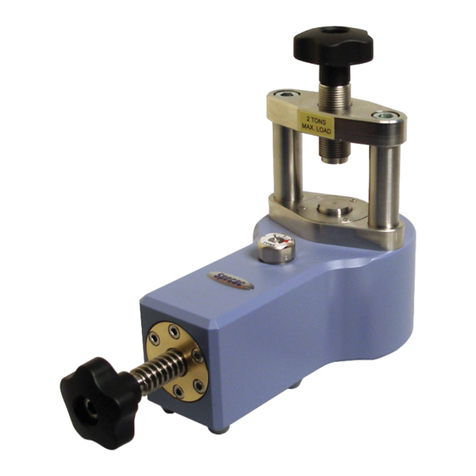
Specac
Specac GS03940 User manual
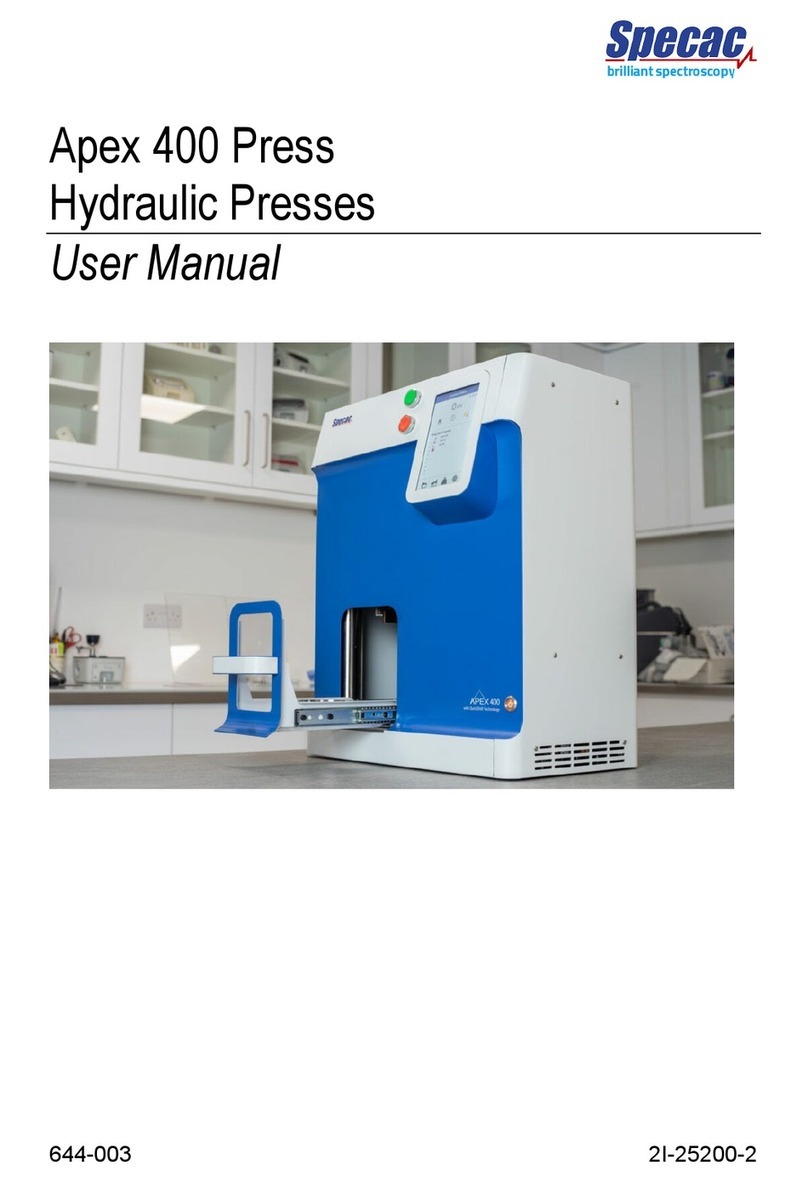
Specac
Specac Apex 400 Press User manual
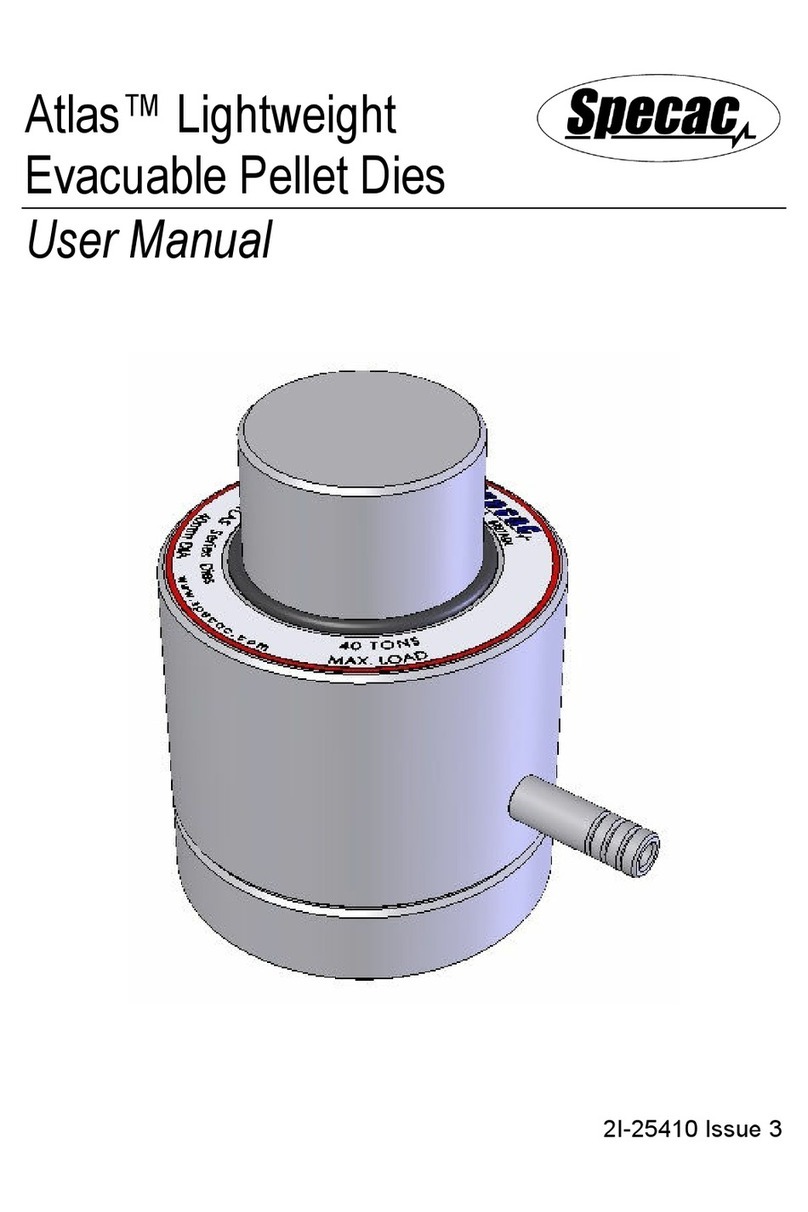
Specac
Specac Atlas Lightweight Evacuable Pellet Die User manual
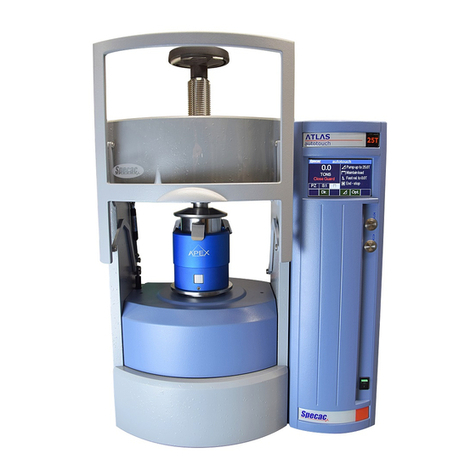
Specac
Specac Atlas Autotouch 40T User manual
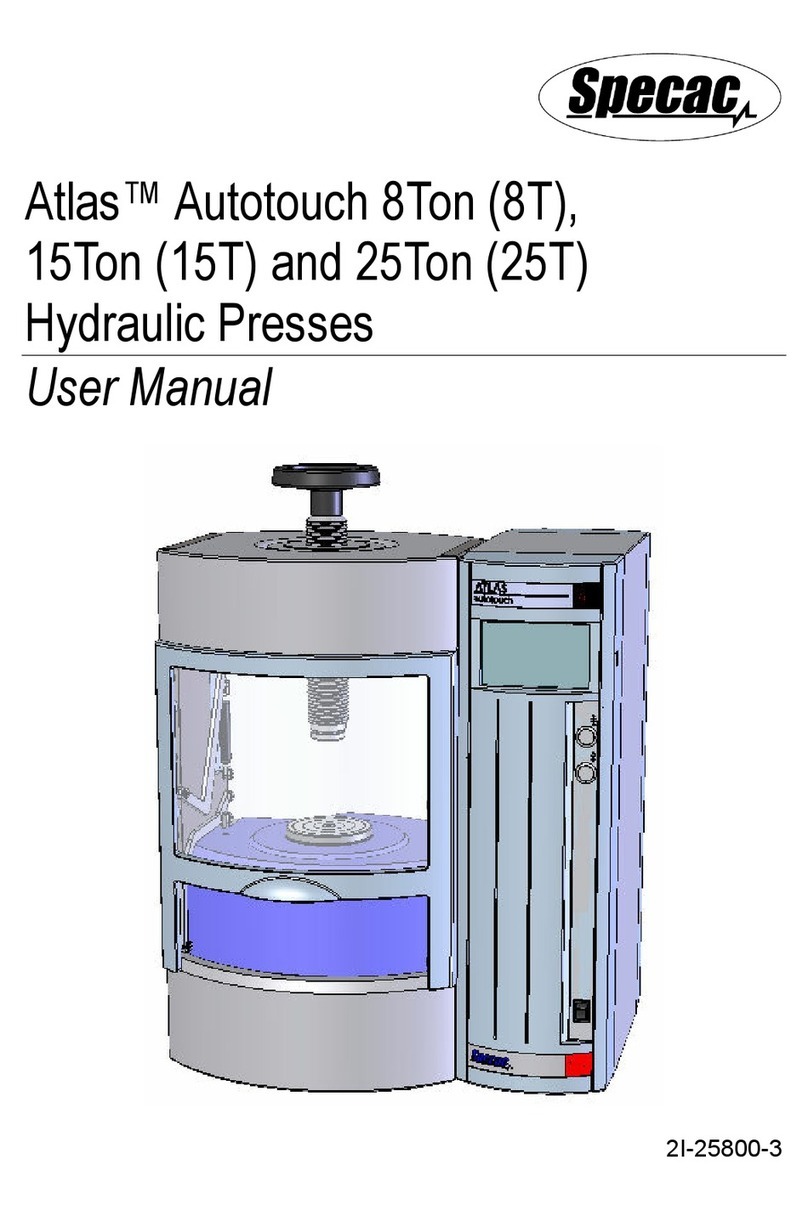
Specac
Specac Atlas Power 8Ton User manual

Specac
Specac Apex 400 User manual
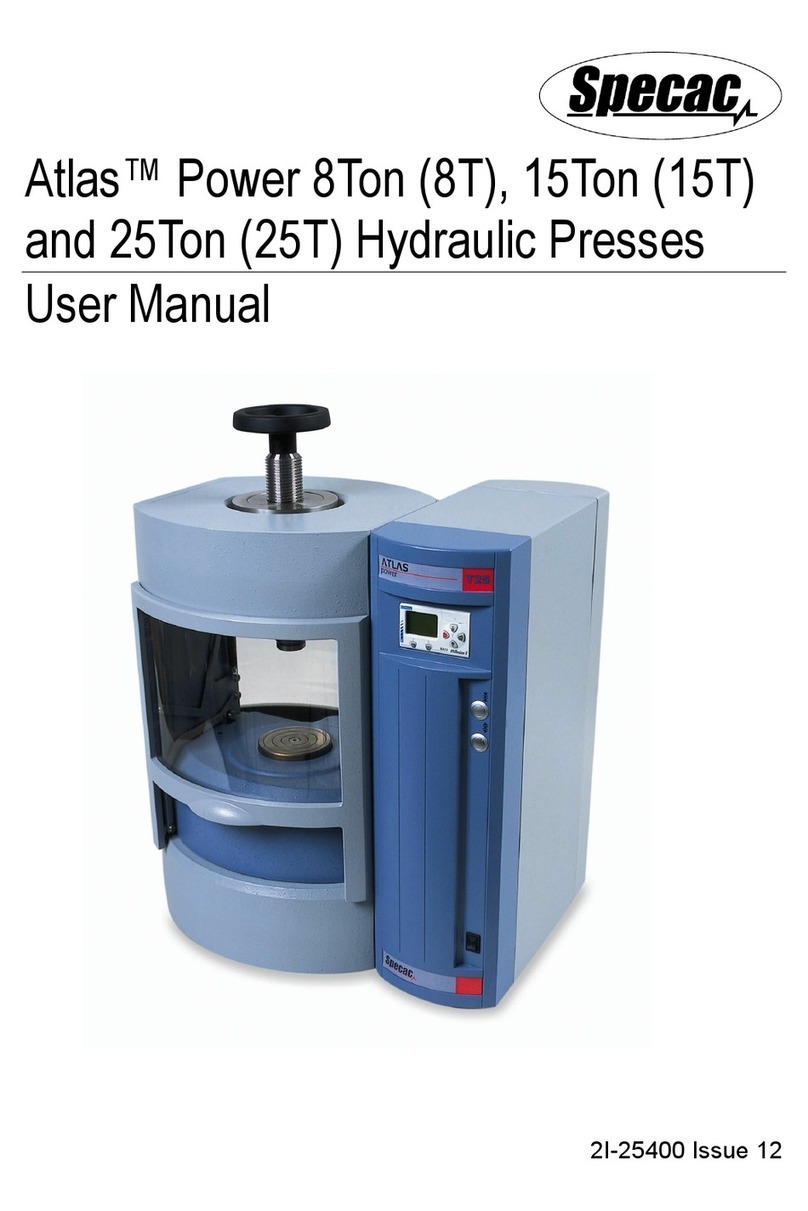
Specac
Specac Atlas Power 8Ton User manual
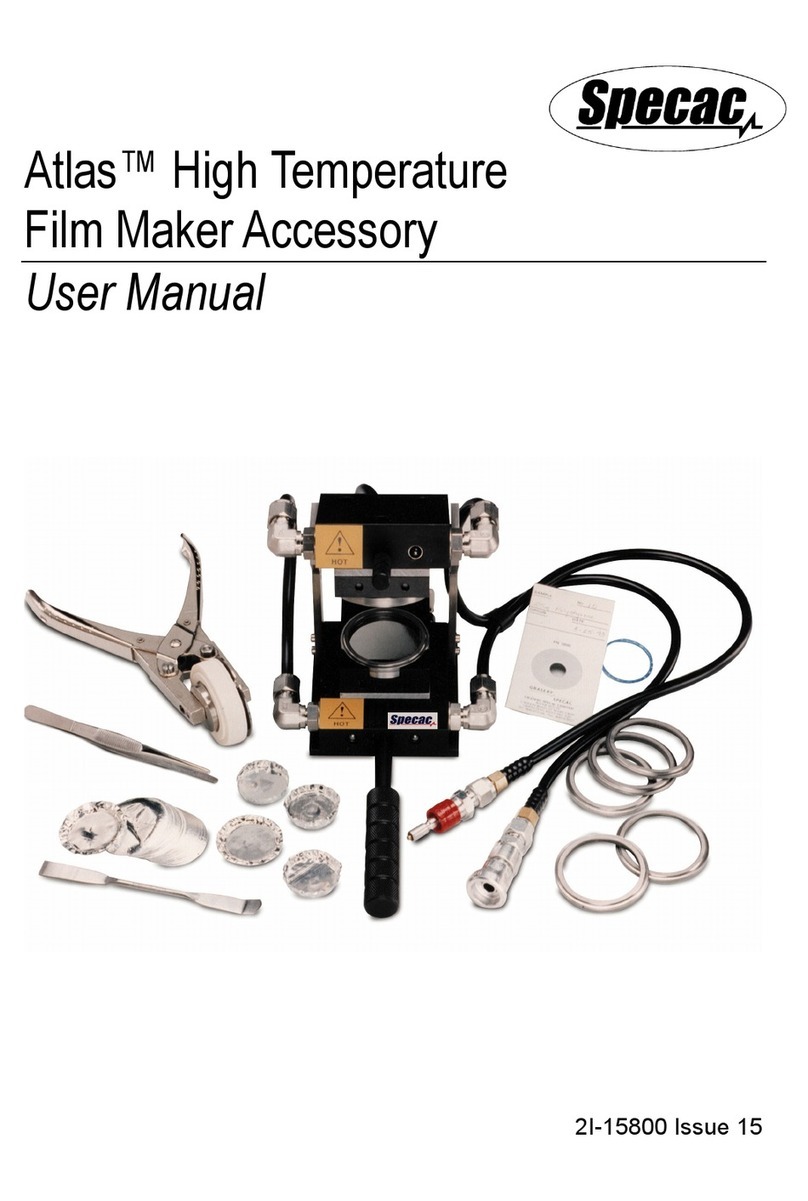
Specac
Specac Atlas GS15800 User manual
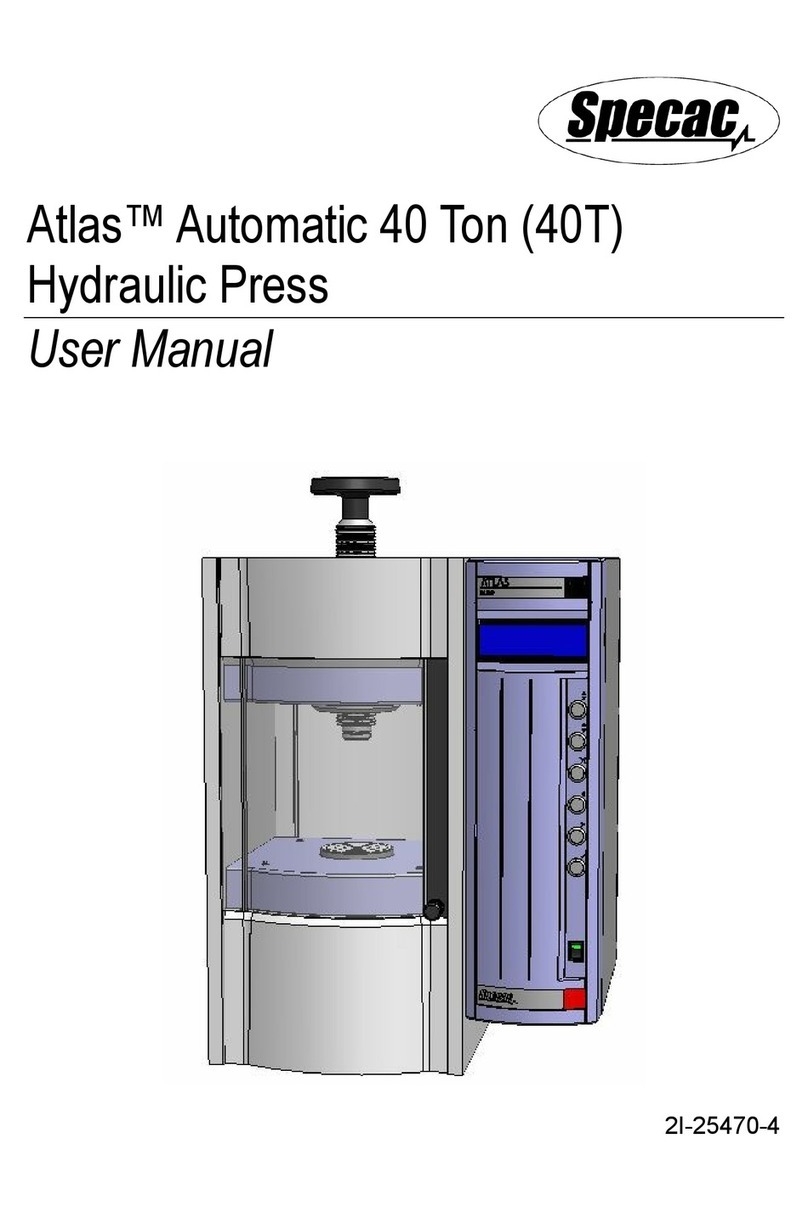
Specac
Specac Atlas Automatic 40 Ton User manual
